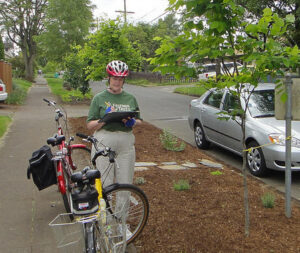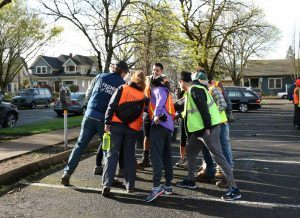Tag: Neighborhood Trees Program
Trees Through The Years
Our inspection program connects volunteers to specific trees, visit after visit.
When Friends of Trees plants a tree, we don’t just wash the dirt off of our hands and move onto the next one. We return to inspect it, to prune it, replenish mulch, and make sure everything is looking good. These check-ups are for more than just to care for that individual tree—we’re also collecting data.
Most of the data that we track is for younger trees, Tiers 1, 2, and 3, according to their age, Tier 1 being trees that were planted in the most recent season. We do this to make sure each tree was planted properly, to track the survival rates of different species, assess the quality of the nursery stock, and keep an eye out for any trends we need to adapt to.
“We also do this to provide tree care advice to the tree recipient,” Haley says. If a tree fails for reasons beyond neglect, we can replace the tree or refund the recipient.
There’s another set of much older trees that we have been collecting data on: Tier Omega. Tier Omega trees were planted in the 2010 season, and we’ve been checking on a subset of them, the same exact subset, every year since they were planted. This has created a consistent and robust data set that can show the long term survival rates of older plantings.
In the summer of 2010, 486 Tier Omega trees were planted. Since then, just 45 trees from the Tier Omega subset have died or were moved due to development reasons. Now that these trees have settled, they’re less likely to be dramatically impacted by weather, so we have been seeing fewer dead trees with each round of inspections.
“There’s this great community feel to it,” Neighborhood Trees Senior Specialist Haley Miller says about the inspection program. “We have some Tier Omega inspectors who have been inspecting the same exact trees for eleven years now.”
Mike Ablutz is one of those Tier Omega inspectors who just keeps coming back. “Revisiting the same trees over several years is like checking in with young friends,” he says. “I love seeing how they are doing, how fast they are growing, and discovering the many ways that they are adapting to life’s challenges.”
When people sign up to get a tree from Friends of Trees, they can volunteer to be tree inspectors. They are assigned a Tier 1 route of about twenty trees, including their own, that need to be inspected twice each summer. Inspectors monitor things like weeds, mulch, and water. They measure the size of the tree and look for things like bark damage. “It’s a popular volunteer role,” Haley says. “People really enjoy visiting their trees.”

The tree inspection process is also one of the ways we engage our youth education programming at Friends of Trees. Our partnerships with the Portland Opportunities Industrialization Center and the Blueprint Foundation connect students and young people to urban forestry work. In the summer, they get to help with tree inspection, which continues to develop forestry skills like tree identification, and grow their connections to nature.
We are learning more and more that when a person feels a connection to a particular tree, it grows their connection to trees and nature more broadly. Our tree inspectors are proof of that.
“I often imagine how the young trees we plant will look when they are old,” Mike says. “Tier Omega inspections allow me to revisit specific trees and at least see how they are doing in their early years.” Hopefully Mike will get the chance to keep revisiting those trees for years to come.
Neighborhood Trees Program FAQ
 Some of the Why, Where, and What-Have-You of planting trees in the city with Friends of Trees
Some of the Why, Where, and What-Have-You of planting trees in the city with Friends of Trees
Since 1989 Friends of Trees has been growing our urban canopy through planting street and yard trees in neighborhoods. A LOT changes during 30 years of tree planting! We continually work with our city and county partners to ensure the right tree is planted in the right place, and since every location is different we are used to getting quite a few questions. Here are answers to some of the questions we get the most:
I want a smaller/larger tree for my planting strip but all the trees on this list are just too big/small, why can’t I get a smaller/larger street tree?
We work closely with our municipal partners and we can only plant trees that are on their approved street tree planting lists. One of the goals of our program, and the partners we work with, is to increase the urban canopy in order to maximize the benefits. In other words, the larger the tree, the more the urban canopy grows, which provides more benefits in terms of cooling in the heat of summer, providing oxygen, and cleaning our air and water. So when a planting site allows it we need to optimize the size of the tree planted, and consequently, maximize the benefits provided. We also want to make sure we aren’t planting trees that are too big, in order to protect existing urban infrastructure. So these same guidelines ensure we aren’t planting over-sized trees in spaces that are too small.
I want to plant a fruit tree in my planting strip and I know you have them, why aren’t they on my list of approved street trees?
Fruit trees are only approved for certain spaces, such as yards or planting strips that are six feet or larger and have overhead primary power lines (however, Vancouver and Clark County do not allow fruit trees to be planted as street trees at all). If you’d like a fruit tree for your yard in addition to your street tree, we offer a wide variety, including apple, pear, plum, fig, and persimmon.
I only want native trees for my street tree and you only have one native on this list, why don’t you plant more natives?
Right Tree Right Place! We love native trees, but many tend to get pretty big and just won’t work in some planting locations due to overhead power lines, if the strip isn’t wide enough, a nearby intersection, etc. We want to make sure your tree is the best tree for your planting spot! We also want to plant as diversely as possible toward a resilient urban forest. P.S. Want to plant some natives? Join one of our Green Space planting events–all natives, all the time.
I want a street tree, but will it break the sidewalk?
Again, Right Tree Right Place! The trees offered by Friends of Trees do not have aggressive root systems and are specially approved to minimize such conflicts. Proper watering also helps. Deep watering for the first three years after planting encourages tree roots to grow deeper in the soil, we recommend 15 gallons a week during the summer for the tree’s first three years, and as needed in the future when temperatures are extreme. Keep in mind that we cannot guarantee that the trees we offer will never buckle sidewalks, as they are living beings and situations vary. We do our best and encourage you to keep an eye on your tree.
I’m concerned that tree roots will damage the sewer pipe, doesn’t this happen?
A tree’s roots grow where the growing is easy, they are opportunistic and not invasive. They do not seek out water or sewer pipes unless the pipes are leaking. Further, 90% of tree roots are in the top 2-3 feet of soil, and most sewer lines are deeper than that. Your municipal tree inspectors take into account the location of your water meter and assigns the planting location within the guidelines of the water company.
Can you help me remove a tree so I can plant a new one with you?
We can’t help you with a tree removal, but you can re-plant with our program if the city allows you to remove your tree. If you want to remove trees in your yard, check with the city to see if there are laws affecting your tree. To remove a street tree, you need a permit. Contact your city’s urban forestry department directly for a removal inspection, a list of contact information for our municipal partners is here. It’s a good idea to request that the city mark “all approved locations.” If you want to re-plant with us after removal please include on your application that you are working with Friends of Trees. Visit our website for more information about tree removal and replacement.
The approved locations where the trees are going are strange, can you change the location?
Unfortunately we can’t change the location. All street tree locations are based on a city inspection, and there are many factors involved, including distance from underground utilities, overhead lights and power lines, utility poles, fire hydrants, intersections, and street signs. Planting in the spot chosen by the inspector will help ensure your street tree has the best shot at surviving–and thriving!
We’re hiring!

Love trees? Looking for meaningful work in a supportive, fun work environment? Then check out our opening for a Neighborhood Trees Specialist.
Neighborhood Trees Specialists implement community-based, neighborhood street tree planting projects in collaboration with volunteer Neighborhood Coordinators, Neighborhood Associations and other partner groups in accordance with the Friends of Trees’ mission. Ideal candidates will be personable, creative and adaptable; have a background or interest in community tree planting and care; able to juggle multiple priorities at once; and have a desire to work with diverse communities and individuals of all backgrounds.
Interested? Details here.


 Some of the Why, Where, and What-Have-You of planting trees in the city with Friends of Trees
Some of the Why, Where, and What-Have-You of planting trees in the city with Friends of Trees